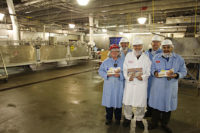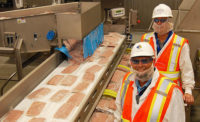
With its increasingly famous “Butterball Turkey Talk-Line®,” TurkeyTalk™ Podcasts and Turkey Lovers Newsletter, Butterball LLC goes all out to convince consumers that its employees are the turkey experts. Depending on each individual consumer, of course, that claim may or may not hold true.
Yet, Butterball’s expertise cannot be contested in the realm of worker safety — an area in which this turkey processor displays a unique mastery, and for which it has garnered unprecedented recognition over the last five years.
In 2008, Butterball celebrated the fact that four of its six U.S. plants held the Occupational Safety and Health Administration’s (OSHA) Voluntary Protection Program (VPP) Star Worksite rating. Companies earning Star status, according to the OSHA Web site, have achieved injury and illness rates at or below the national average of their respective industries.
The Butterball locations that lay claim to this prestigious honor include Jonesboro, Huntsville and Ozark, Ark., and Carthage, Mo. In addition, Butterball’s Mt. Olive, N.C., facility holds the North Carolina OSHA VPP “Rising Star” status. These achievements were attained only after a long, hard journey that required organizing priorities and the workforce culture down through the ranks of the production associates. Huntsville complex manager Bill Folk, a three-decade industry veteran, explains that Butterball’s commitment was strong from the get-go.
“When I was here in the early 1990s, we began the process,” he says. “Butterball as a company looked out there and said, ‘You know what, we’ve got to be concerned about our employees’ safety because, No. 1, it’s the right thing to do. No. 2, there are costs associated with it. Worker’s compensation dollars can get into the millions in a large facility if you’re not careful.”
Adoption of this strategy and the dedication to stick to it through the tough early years has paid dividends today. Presently, the Huntsville plant’s total worker-compensation expenses on a per employee basis compute out to about $11 per employee for 2008 — or $8,800 total for the year. Compare that, Folk says, to the industry average of $533 per employee — or $426,000 (based on the total number of employees at the Huntsville plant) for the entire year.
However, despite this potential cost savings, he adds, “you’d be amazed at how few companies in the meat industry have taken on this challenge. The meat industry is a notoriously difficult industry. It requires a lot of hard labor, including knife and cutting work that poses a high risk for injury.”
Indeed, of the approximately 2,000 VPP sites (including Star, Merit and Demonstration levels) across all industries and jurisdictions in 2008, only eight were grouped into the Poultry Slaughtering and Processing category. Butterball owns half of those distinguished plants, and all four are considered Star Worksites.
Trickle-down effect
Buy-in from all employees is crucial, particularly if a company is looking to gain the recognitions attained by Butterball. The company recognized the need for employee participation early on and made sure it opened the lines of communication with all its employees on the goals, strategies and results as they came in.“Our production associates come to work every day, and they have a genuine desire to do well,” Folk explains. “They’re not just another piece of machinery. They are the human factor that distinguishes Butterball as a world-class producer.
“Our job is to communicate and give them the challenge, excitement and feedback that we all want,” he adds.
Feedback provided the spark necessary to take worker safety to an entirely new level within the walls of the Huntsville plant. From 1994 through 2002, the facility was recognized by Arkansas’ labor board for completing 10 million man-hours without a lost-time injury. As Huntsville reached each new level, from 1 million to 2 million and so on to 10 million man-hours, employee enthusiasm for the program grew tremendously.
“When we were recognized for each million, our employees became increasingly invested in reducing the hours of lost-times we accumulated,” he explains. “But once we reached that landmark, we took our goals to the next level and set our sights on reducing our numbers of recordable injuries.”
It produced exactly the type of employee reaction Butterball desired in its program development.
“We started our safety initiatives by influencing employees to think about worker safety every day. Then we made it part of the environment and fabric of the workplace,” Folk said. “We are proud to have accomplished that structure because it was a vital part of jump-starting our programs and initiatives.”
Butterball’s success in engaging the employees with the worker-safety program allowed for each production associate to have ownership in its success. This helped keep the program intact during any time of leadership changes or transitions for the plant.
“That tells you that the employees are the driving force behind our safety initiatives,” Folk said, “They are the ones who keep pushing it. Through changes in complex managers, they’ve never wavered and have continued to reduce our rates of lost-time injuries.”
Plan of attack
Folk believes a few initiatives at the Huntsville facility have been key to improving worker safety. First and foremost, the plant’s management-accountability program has offered a tremendous boost to worker safety by providing a measurable accountability process for all levels down to the supervisor. Simply put, management is responsible for maintaining worker-safety strategies, programs, solutions and initiatives throughout in their departments.“Our managers understand that they play a key role in maintaining the program,” Folk says. “Through meetings, as well as behavioral and weekly audits, they monitor how effectively our production associates are aligning practices with the standards set forth in our worker-safety programs.”
Managers and supervisors are scored on their performance in various worker-safety strategies. Although low scores currently are not a problem at the plant, there is a system in place if an individual’s score slips.
“The supervisors are evaluated on 11 worker-safety categories, and a low score does have punitive implications associated with it,” Folk says, “If they score below an 80, it definitely impacts what they see on their performance review.”
Butterball’s intensive corporate safety audit is performed once a year by the director of safety and risk management and three safety managers from other facilities. It is a weeklong, in-depth review of a plant’s performance in 59 areas of safety and health, and it includes a full review of all documents, a comprehensive walk-through inspection and management and employee interviews. Huntsville exceeded corporate expectations in this audit, scoring a 92.5 percent in 2008.
The Huntsville facility’s internal audit program is equally thorough. Daily audits are performed by production associates, typically the area’s representatives on the VPP team. In addition, supervisors perform weekly audits, which are mandatory and factored into their management-accountability scores.
The plant’s training program goes a long way toward ingraining the importance of worker safety into the mindset of new employees. Furthermore, the training program aligns with the plant’s ergonomics program to ensure new employees are well-versed to perform their jobs properly (See “A long journey” on page 50 for more on the health-services and training teams).
In the realm of continuous improvement, Huntsville has two programs that keep things moving in a positive direction: PIP (Process Improvement Program) and SHARP (Safety, Health, Accident, Reduction Plans). PIP is a maintenance log, in which worker-safety and USDA issues take top priority. Maintenance employees review this log and use it to help track any potential hazards until they are addressed.
SHARP is created for supervisors in their area of responsibility, and it challenges those teams with four annual objectives that they must work toward throughout the year in order to help reduce facility incident rates.
Cutting out the cuts
With such a high standard set, it seems as though any future improvement in worker safety would be difficult, if not impossible, for a plant such as Huntsville. Yet, Folk believes the plant continues to progress toward the next step.“Our opportunity for improvement is to increase our focus on behavioral safety,” he says. “We now have to place a focus on reducing those minor injuries like pokes and cuts that occasionally occur and influence our injury rates.”
The fact that employees at the Huntsville plant take pride in their sparkling worker-safety record gives this initiative a big boost. One potential short-term challenge at Huntsville in the future will be training employees on the delicate balance between hitting production numbers and safety goals. Folk said typical injuries lately have involved the production associates ambition to perform their jobs completely and correctly.
“Many of our smaller injuries involve workers going beyond the duties of their job to help others,” he explains. “The problem usually comes from a worker that couldn’t make their cut quickly enough, so they follow the bird too far, and accidentally poke the person next to them.”
Although the company encourages and appreciates this type of job commitment, Butterball must remain conscious of these small incidents because they also contribute to the factors that create unsafe work conditions or situations.
If Huntsville can succeed in this next step and drive its safety ratings higher, it will further cement Butterball’s reputation as an expert not only in turkey production, but also in worker health and safety.
With a workforce that is pushing hard to attain loftier goals such as these, there is no “star” — whether a rating, status or goal — that is too far out of Butterball’s reach.
Butterball at a Glance
At a Glance: Butterball LLCHeadquarters: Garner, N.C.
Plants: Six: Mt. Olive, N.C.; Jonesboro, Ozark and Huntsville, Ark.; Longmont, Colo.; Carthage, Mo.
Employees: Approximately 6,000
Capacity: 1.4 billion pounds produced annually; up to 210,000 turkeys processed daily
Revenue: $1.4 billion annually
Key executives: Keith Shoemaker, CEO; Joe Nalley, COO; Edward Kacsuta, CFO; Kerry Doughty, executive V.P., sales & mkt.; Gary Lenaghan, V.P., human resources; Alice Johnson, D.V.M., V.P., food safety, government regulations and public affairs; Dennis Stover, V.P., corporate controller
A long journey: Q&A with Jim Gilbert, safety manager, Butterball
Jim Gilbert has been at Butterball’s Huntsville, Ark., facility since 1998, and has watched the worker-safety programs grow at the facility. Given Gilbert’s experience as a major part of the development and success of the VPP program, The National Provisioner’s executive editor, Andy Hanacek, got his take on where the company and facility had been, where it stood on worker safety currently and where it is headed.Hanacek: What were some of the major changes that helped spur along worker safety initiatives at Butterball and its Huntsville plant?
Gilbert: At the onset of Butterball, LLC two years ago, the company worked hard at combining best practices, which spurred the implementation of a company-wide safety audit that is based on VPP. Our safety audit spans the entire company and builds on what was already in place. We realized that passing the corporate safety audit gave us the capability to be a VPP site, which was a major starting point for our initiatives.
Hanacek: We talked about how, through the changes in ownership, VPP was able to weather those transitions based on the fact that it’s run by the employees. Do you agree that was the key factor in its survival through the years?
Gilbert: I do agree. The safety culture had changed, as a result of the employees assuming responsibility for the program, so staff changes never compromised the safety culture that was already in place. Naturally, complex or safety managers would not join a company without recognizing the importance of safety, but having the program set up made it more plausible for them to step in and take it to the next level.
Hanacek: What set Butterball apart in this realm of employee safety?
Gilbert: I think what sets us apart is the definitive management commitment, which starts with Keith Shoemaker, our CEO, and cascades all the way down through our COO, Joe Nalley, to our vice president, Tim Scanlan and then to Bill Folk, Huntsville complex manager. We are all required to respond to the feedback employees offer. That is what helps us highlight area of improvement for our safety procedures.
Hanacek: How did your team create that buy-in during development of the program and get worker safety engrained into the culture of this facility?
Gilbert: We did a lot of training sessions and just led by example to show them we’re really committed to safety, whether it’s a management position or a production associate. Once we put the program in place, got the management commitment really strong and our production associates on the committees providing feedback, things started falling into place. Our injuries and illnesses reduced, and we achieved the level required to become a VPP site.
Hanacek: So was it more of a strict enforcement of the standards or just holding people accountable?
Gilbert: I think it was a combination of accountability and also having fun with it. We do a lot of safety awareness events, a lot of safety campaigns, play a lot of safety games, and sometimes we just play a game that has no numbers or goal associated with it. Tim Scanlan, our vice president, has said, ‘Sometimes you just gotta do something to have fun with the message.’ It’s just a fun team atmosphere. I think you can see that from my group — we have fun. But at the end of the day, they know they have a job to do, and they get that job done.
Hanacek: Let’s talk about the development of your department. How did it all come together?
Gilbert: When developing our department, we realized that training was an essential component to developing a high-skilled staff. We put an extensive training team together and started seeing immediate results in our turnover and retention. We also noticed that we needed trainers that could directly communicate with our large Hispanic workforce. Our trainers are all bilingual, which helps productivity and morale. Today, the training department works for the safety department, helping us to achieve our company goals.
Hanacek: What other changes had a significant impact upon the culture here at the Huntsville plant?
Gilbert: I think the medical management program made a big impact. We have a very comprehensive medical management program. Phyllis Earles, our health-services supervisor, has been the leading driver of that. When we have a new associate who comes on board, we conduct post-hire medical questionnaire and grip-strength testing. For the first 10 days of employment, the nurse actually examines their hands for any symptoms or signs of redness, swelling and things like that. They monitor that associate all the way until they are fully ramped in. If they’re starting a job with a 10-day ramp-in, for example, that employee’s not actually spending eight hours a day on that job until they are here 10 days. The rest of the time they’re rotated onto different jobs that use different muscle groups and also pulled out for periods during the day for additional classroom training.
Hanacek: Behavioral auditing is the next major step for thisprogram, correct?
Gilbert: Yes. We have a behavioral auditing process in place very similar to the DuPont STOP system that is still being developed. We’ve only had a few injuries and illnesses this year, but if you look at the trend analysis on each one of those, it was a behavioral thing that caused it. So that tells us we have room for improvement. We have a very intense corporate safety audit, and I’ve talked with our director of risk management that is planning to incorporate a behavioral audit component into it. We’re trying to stay ahead of the curve by improving our behavioral auditing because that might take us to the next level and help us sustain the industry-leading practices that make Butterball so successful.
Facility Facts
Location: Butterball’s Huntsville, Ark., plantOpened: 1974
Size: approx. 135,000 square feet; plus 5,000-square-foot dry storage
Employees: approx. 840
Products: whole birds, tray-pack parts, boneless roasts, bone-in breasts, bulk parts, mechanically separated products, smoked & baked whole birds and parts
Throughput: more than 186 million pounds annually
Management: Tim Scanlan, vice president of operations; Bill Folk, complex manager; Rick Bertrand, plant manager; Jim Gilbert, safety manager; Joe Adrian, HR manager; Rick Bohonek, plant engineer; Brian Hill, distribution manager; Irving Young, director of corporate quality
Worker safety awards/honors: VPP Star site, Oct. 2003; recertified as a VPP Star site, 2006 (valid through 2010); VPP Star Among Stars award, 2006 and 2007; inclusion in OSHA VPPPA Best Practice directory, 2006 and 2007




Report Abusive Comment